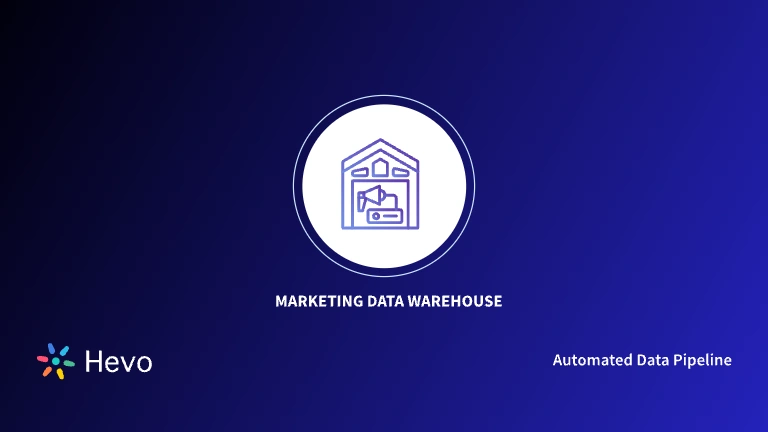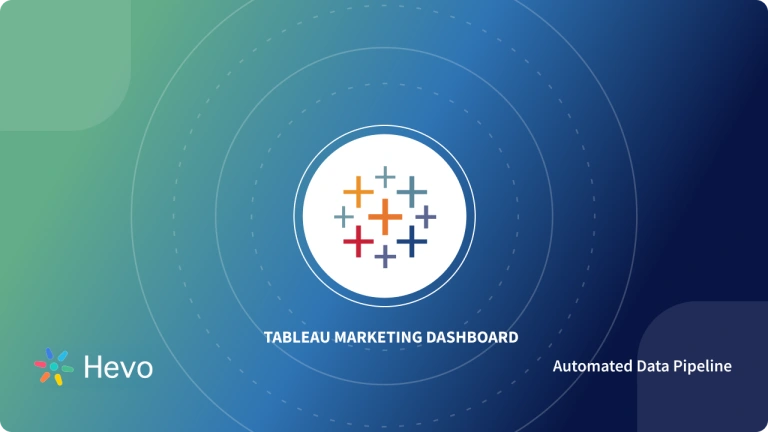Digital Marketers employ many scientific techniques and tools when it comes to visualizing Marketing Data. One such technique is the use of the Marketing Dashboard. Marketing Dashboard provides Marketing teams with simple and visually-appealing displays of the KPIs (Key Performance Indicators) and metrics the organization uses to monitor their performance regularly.
This article provides a comprehensive list of the 10 best Marketing Dashboard/s. It also talks about their usage and benefits to organizations. Read along to find out about this interesting topic, and as a bonus, you’ll also look at digital marketing dashboard examples to strengthen your understanding.
Table of Contents
What is a Marketing Dashboard?
A Digital Marketing Dashboard is a tool that is used to track and display KPIs to analyze Marketing and business efforts over time and across multiple channels. It’s also a Marketing agency’s way of communicating the value of their work to their clients. For Digital Marketing agencies, an online marketing dashboard is a perfect way to showcase the results of their numerous Marketing efforts in real-time.
The capacity to rapidly and viably survey KPIs from a range of advertising activities is crucial to ensure that marketing experts can demonstrate their strategies to their partners at any point in time. The present Dashboards come pre-loaded with detailed charts and representations, and they illustrate:
- Soft Metrics: These include Consumer Loyalty, Commitment, and Brand Awareness.
- Hard Metrics: These include Income Changes and Pace of Return.
- Internet Marketing Metrics: These include Cost-Per-Lead (CPL), Recent meetings, and CTR (Click Through Rate).
Take advantage of Hevo’s novel architecture, reliability at scale, and robust feature set by seamlessly connecting it with various Marketing tools. Hevo’s no-code platform empowers teams to:
- Integrate data from 150+ sources(60+ free sources).
- Simplify data mapping and transformations using features like drag-and-drop.
- Easily migrate different data types like CSV, JSON, etc., with the auto-mapping feature.
Join 2000+ happy customers like Whatfix and Thoughtspot, who’ve streamlined their data operations. See why Hevo is the #1 choice for building modern data stacks.
Get Started with Hevo for FreeBenefits of Marketing Dashboard
Strategy Dashboards can help showcase soft metrics (commitment, interaction, awareness, and so on). However, you’ll need a Dashboard that can also showcase hard metrics (like the inner pace of return and the net present value of your current campaigns) alongside web-based showcasing metrics (for example, bounce rate, total visits, CTR, etc.). This is the reason you’ll need to use a marketing dashboard. Coming up next are only a couple more reasons why incorporating a promotional Dashboard will be tremendously advantageous for your business:
- It helps to customize your Dashboard up to your requirements.
- It helps to track the performance of your advertising efforts.
- It keeps your group in the same spot.
- It makes efficient decisions.
What Metrics Can You Monitor Through Your Marketing Dashboard?
Key Metrics for a Marketing Dashboard
- Website Traffic: Sessions, Users, Pageviews, Bounce Rate, Avg. Session Duration
- Lead Generation: Leads, Conversions, CPL
- Social Media: Followers, Impressions, Reach, Engagement Rate
- Email: Open Rate, CTR, Unsubscribe Rate
- Paid Ads: CPC, CTR, Conversion Rate, ROAS
- Customer Value: CLTV, ACV, CAC, Retention Rate
- Sales: Revenue, Sales Growth, Conversion Rate
By tracking these metrics, you can analyze campaign performance, identify areas for improvement, and make data-driven decisions to optimize your marketing efforts.
Top 10 Marketing Dashboards
Given below are the 10 best marketing dashboards, along with marketing dashboard examples that cover various critical metrics that your organization might require:
- Marketing Performance Dashboard
- Digital Marketing Dashboard
- SEO Analytics Dashboard
- Online Marketing Dashboard
- Social Media Dashboard
- Google Analytics Dashboard
- Content Marketing Dashboard
- Email Marketing Dashboard
- Web Analytics Dashboard
- E-Commerce Marketing Dashboard
1) Marketing Performance Dashboard
This type of dashboard shows a high-level outline of the change channel and other related metrics. It helps marketers to make educated choices about conversions, revenue, and lead generation. It tracks metrics such as leads, site visits, and conversions through genuine worth so Marketers can check what establishes an effective showcasing effort.
Given below is an example of this type of Dashboard.
2) Digital Marketing Dashboard
This type of Dashboard keeps track of a business’s advanced and web-based showcasing endeavors, allowing Marketers to settle on educated choices around planning. It follows a crusade execution just as other computerized advertising measurements. It tracks metrics that allude to online media promoting, email crusades, AdWords (presently Google Ads), crusades, Facebook advertisements, site traffic, and more to help focus on the spending plan and shows progress towards objectives. HubSpot’s Marketing Analytics and Dashboard Software allows you to streamline this process, providing comprehensive insights into campaign performance and audience engagement across various channels.
Given below is an example of this type of Dashboard.
3) SEO Analytics Dashboard
This type of Dashboard is used to estimate SEO execution through numerous metrics. This information is fundamental to the Marketing group to keep track of their website’s achievements in organic search engine results pages. It features territories that need improved streamlining, the best converting catchphrases, the top-performing pages, and more. SEO aims to direct people to the organization’s website with backlinking, internal linking, and various other strategies.
This Dashboard tracks Analytics from devices similar to Google Analytics. It tracks things like the number of keywords on the page, organic traffic versus various kinds of traffic, the page’s loading speed, the number of indexed pages, the number of backlinks to a page, and more.
Given below is an example of this type of Dashboard.
4) Online Marketing Dashboard
This Dashboard provides advertisers with an outline of their Online Marketing efforts. It arranges data from various advertising channels, providing a high-level view with the capacity to penetrate the channel. It will follow channels like Email Marketing, Social Media Stages like Linkedin, and PPC (Pay-Per-Click) campaigns.
The primary metric it needs to follow is the Conversion Rate. These metrics should be on all Dashboards as they show the number of individuals who convert to a lead or a client visiting a landing page or a similar page.
Given below is an example of this type of Dashboard.


5) Social Media Dashboard
This Dashboard layout tracks Social Media KPIs. Social Media is turning into a strong traffic source. However, it can be hard to follow because it is not the initial interaction source, meaning Marketers often have to view Analytics and data directly on the Social Media platform.
It tracks the Social Media examination to provide Marketers with a firm overview of performance and engagement on Social Media and whether leads are navigating to the website. Metrics that are tracked include likes, shares, new followers, engagement, top posts, growth, and loss.
However, each Social Media stage can follow its data, but the Dashboard arranges the information, so it is in one spot instead of on numerous destinations.
Given below is an example of this type of Dashboard.
6) Google Analytics Dashboard
Google Analytics Dashboard refers to the Dashboard given by Google Analytics and is generally acknowledged as one of the essential Marketing KPI Dashboards for website data. However, Google Analytics information can be brought into other Dashboards, as you’ll see in the example below. It offers quick and straightforward access to KPIs for rapid assessment of success and lets Marketers analyze and change tactics where required.
This Dashboard tracks critical metrics for website traffic in one spot. This includes KPIs like bounce rate, session length, conversion interaction, channel performance, source, overall traffic, and more.
Given below is an example of this type of Dashboard.
7) Content Marketing Dashboard
This Dashboard looks at the details around Content Marketing and checks whether its efforts are successful. The information is followed, observed, and afterward surveyed to give content advertisers valuable insights.
It offers predictable checking to guarantee that advertisers can survey and change their substance-promoting strategies to ensure positive changes and improvement. The Metrics are chosen based on the engagement of the user with the content. For example, reads, downloads, comments, shares, likes, as well as sales, inbound links, conversions, and referral traffic are some of the metrics that are chosen.
Given below is an example of this type of Dashboard.
8) Email Marketing Dashboard
An Email Marketing Dashboard provides a quick snapshot of the Emails. It may be designed with Email marketing apps and can also include other Google Analytics applications. It helps organizations as it provides the option to explain initially how your Email Marketing efforts are performing and the level of engagement you are creating.
It will track an Email list’s well-being (for example, the quality leads on your email list), engagement over a set time, bounce rate, unsubscriptions, new subscribers, open rates, and CTR.
Given below is an example of this type of Dashboard.
9) Web Analytics Dashboard
This Dashboard looks into the website performance of Market objects in real-time. It tends to be applied to different time frames, too, including various data types. This allows users to analyze both real-time data and patterns over the long run. It follows metrics such as bounce rate, recent visitors, page views, returning visitors, traffic references, and other KPIs to show client corporations.
Given below is an example of this type of Dashboard.
Want to optimize your marketing insights? Explore our blog Marketing Data Warehouse: An Easy Guide and Everything You Need to Know to learn how a data warehouse can enhance your dashboards!
10) E-Commerce Marketing Dashboard
This type of Dashboard shows the metrics and KPIs specific to an internet business website on a progressive premise. Advertisers can settle based on the choices of online businesses. This allows marketers to adjust to the ongoing patterns and stay aware of the advancing web-based business environment. It follows metrics such as ROI (Return On Investment), bounce rate, CPL, traffic sources, conversions, total income, and complete sales.
Given below is an example of this type of Dashboard.
Why Do You Need a Marketing Dashboard?
You need a marketing dashboard to:
- Communicate Results: Share performance updates with stakeholders clearly and effectively.
- Track Performance: Monitor key metrics (KPIs) across all channels in one place.
- Identify Trends: Spot patterns and understand how campaigns are performing over time.
- Make Data-Driven Decisions: Use insights to adjust strategies and optimize campaigns.
- Improve Efficiency: Save time by accessing all your data in a single, easy-to-use view.
Conclusion
This article gave a comprehensive list of the best Marketing Dashboards. It also explained the importance and benefits they provide to an organization. Overall, Marketing Dashboard is an excellent solution when it comes to documenting data visually and monitoring the metrics regularly. Companies can use different types of Dashboards according to the data they want to document. Presenting data visually not only helps technical users but also non-technical users who find it difficult to read data. Sign up for Hevo’s free trial to migrate data for creating such dashboards easily.
Share your experience of understanding in the comments section below!
FAQs
1. How do I create a digital marketing dashboard?
Use tools like Google Data Studio, Tableau, or Power BI to compile key metrics from platforms like Google Analytics, social media, and email marketing into a centralized, visual dashboard.
2. What is an SEO dashboard?
An SEO dashboard tracks and displays SEO metrics like organic traffic, keyword rankings, backlinks, and site performance in an easily digestible format.
3. Is the dashboard a KPI?
No, a dashboard is a tool to visualize multiple KPIs (Key Performance Indicators) and metrics for decision-making.





